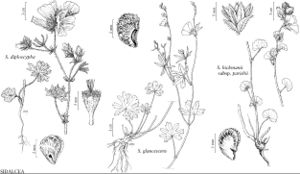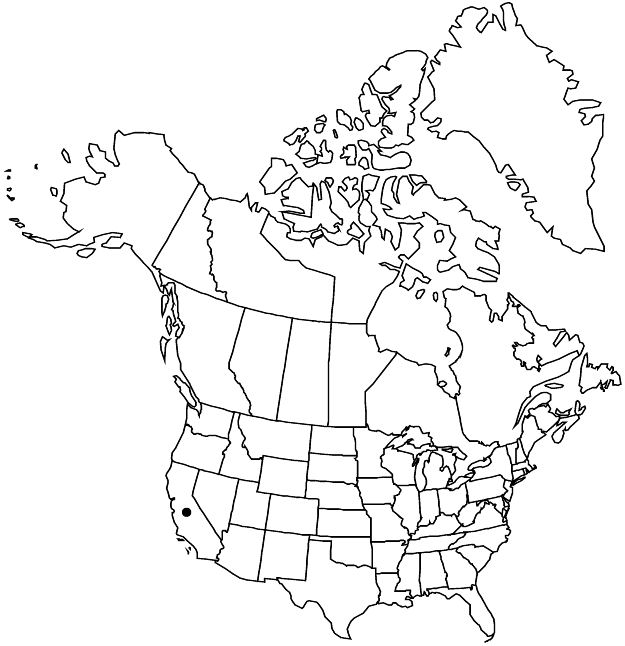Difference between revisions of "Sidalcea hickmanii subsp. parishii"
Perenn. Sp. Sidalcea, 79. 1957.
FNA>Volume Importer |
FNA>Volume Importer |
||
| Line 18: | Line 18: | ||
|label=Selected by author to be illustrated | |label=Selected by author to be illustrated | ||
}} | }} | ||
| − | |basionyms={{Treatment/ID/ | + | |basionyms={{Treatment/ID/Basionym |
|name=Sidalcea hickmanii var. parishii | |name=Sidalcea hickmanii var. parishii | ||
|authority=B. L. Robinson | |authority=B. L. Robinson | ||
| + | |publication_title=in A. Gray et al., Syn. Fl. N. Amer. | ||
| + | |publication_place=1(1,2): 307. 1897 (as hickmani) | ||
}} | }} | ||
|synonyms={{Treatment/ID/Synonym | |synonyms={{Treatment/ID/Synonym | ||
| Line 40: | Line 42: | ||
|elevation=1000–2200 m | |elevation=1000–2200 m | ||
|distribution=Calif. | |distribution=Calif. | ||
| − | |discussion=<p>Subspecies parishii is the most variable of the subspecies and is found in at least two widely distant, isolated populations, each with metapopulations. It most closely resembles <i></i>subsp.<i> hickmanii</i>; it can be distinguished from that by its wider, longer bracts, its more deeply crenate leaves, and its range. It is threatened by grazing, urbanization, fire-suppression, and road maintenance, and is listed as rare in California. Subspecies parishii is found in the outer South Coast Ranges, western Transverse Ranges, and San Bernardino Mountains in Santa Barbara and San Bernardino counties.</p><!-- | + | |discussion=<p>Subspecies parishii is the most variable of the subspecies and is found in at least two widely distant, isolated populations, each with metapopulations. It most closely resembles <i></i></i>subsp.<i><i> hickmanii</i>; it can be distinguished from that by its wider, longer bracts, its more deeply crenate leaves, and its range. It is threatened by grazing, urbanization, fire-suppression, and road maintenance, and is listed as rare in California. Subspecies parishii is found in the outer South Coast Ranges, western Transverse Ranges, and San Bernardino Mountains in Santa Barbara and San Bernardino counties.</p><!-- |
--><p>Of conservation concern.</p> | --><p>Of conservation concern.</p> | ||
|tables= | |tables= | ||
| Line 65: | Line 67: | ||
|publication year=1957 | |publication year=1957 | ||
|special status=Conservation concern;Endemic;Selected by author to be illustrated | |special status=Conservation concern;Endemic;Selected by author to be illustrated | ||
| − | |source xml=https://jpend@bitbucket.org/aafc-mbb/fna-data-curation.git/src/ | + | |source xml=https://jpend@bitbucket.org/aafc-mbb/fna-data-curation.git/src/f6b125a955440c0872999024f038d74684f65921/coarse_grained_fna_xml/V6/V6_609.xml |
|subfamily=Malvaceae subfam. Malvoideae | |subfamily=Malvaceae subfam. Malvoideae | ||
|genus=Sidalcea | |genus=Sidalcea | ||
Revision as of 20:16, 24 September 2019
Plants 0.4–0.8 m, with caudex and taproot. Stems erect, gray-green, sometimes brick-reddish proximally, coarsely stellate-hairy, hairs grayish, to 2 mm diam. Leaves: stipules lanceolate, 5–6 × 2 mm; petiole 2–3(–7) cm, 1/2–3 times as long as blade, shortest on distalmost leaves; blade rounded to truncate or wide-cordate, unlobed or very shallowly lobed, margins crenate, proximal 3–7(–10) × 3–7(–10) cm, distal usually flabelliform, unlobed or very shallowly incised to 1/4 length, 2–3 × 1.8–2.5 cm, surfaces stellate-hairy, hairs usually overlapping. Inflorescences erect or ascending, often dense and spiciform when young, more open and elongating in age, unbranched or few-branched, 2–10 cm; bracts paired, distinct, broadly lanceolate, 5–7(–10) × 2.5–4 mm, much longer than pedicels, slightly shorter than calyx. Pedicels 1–2 mm, obscured by bracts; involucellar bractlets 3, 5–7 mm, equaling or slightly shorter than calyx. Flowers bisexual; calyx 8–10 mm, stellate-hairy, often sparsely so, sometimes with coarser, longer, stellate hairs; petals pale pink to pinkish lavender, 11–15 mm; staminal column 6–7 mm, hairy; anthers white to pale yellow; stigmas 6 or 7(–10). Schizocarps 5–7 mm diam.; mericarps 6 or 7(–10), (1.5–)2–2.5 mm; back and margins with 9 corrugations. Seeds 1.5–2 mm. 2n = 20.
Phenology: Flowering Jun–Aug.
Habitat: Chaparral, cis/montane woodlands, open conifer forests
Elevation: 1000–2200 m
Discussion
Subspecies parishii is the most variable of the subspecies and is found in at least two widely distant, isolated populations, each with metapopulations. It most closely resembles subsp. hickmanii; it can be distinguished from that by its wider, longer bracts, its more deeply crenate leaves, and its range. It is threatened by grazing, urbanization, fire-suppression, and road maintenance, and is listed as rare in California. Subspecies parishii is found in the outer South Coast Ranges, western Transverse Ranges, and San Bernardino Mountains in Santa Barbara and San Bernardino counties.
Of conservation concern.
Selected References
None.

